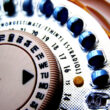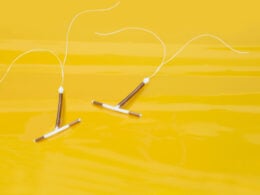Male reproductive health has been in decline since the 1960s. Once considered a global problem by the 1992 study “Evidence for decreasing quality of semen during past 50 years,”[i] it has been shown that the decline in semen quality is largely limited to Western countries.[ii]
Specific studies, largely carried out in the 90s, showed falling sperm counts:
- in Belgium— where the “percentage of candidate donors with sperm characteristics below the 5th percentile cut-off value of a normal fertile population increased from 13 to 54% during the [19 year] observation period.”[iii]
- in Canada — where overall sperm quality showed “a significant downward trend in sperm concentration among 48,968 samples from Canadian men.”[iv]
- in Spain — where “a statistically significant decline was observed in the percentage of normal spermatozoa” between 1960 and 1996.[v]
- in France: Arecent study of over 26,600 samples found that the average sperm count of a man living there dropped by a third between 1989 and 2005.[vi]
- in Scotland[vii] and in Denmark[viii]– to name a few other.
In the same places, and over the same time periods, there have been noted increases in male reproductive diseases. A 2003 study showed that the rate of testicular cancer doubled over the last 30 years “in the majority of industrialized countries in North America, Europe and Oceania.”[ix] A review of multiple studies entitled “Are Male Reproductive Disorders a Common Entity?” found evidence for “high and possibly increasing frequencies of undescended testis and hypospadias” (a birth defect of the urethra in the male that involves an abnormally placed urinary opening) as well.[x]
So, what have Western societies been doing since the 1960’s that could be negatively effecting male reproductive health? The 1995 study “Do environmental estrogens contribute to the decline in male reproductive health?” suggested that increased exposure to artificial estrogens may be the primary factor harming male health today.[xi]
The hypothesis has been validated by subsequent research. In utero exposure to artificial estrogens negatively impacts male reproductive health. The 2006 study “Estrogen effects on fetal and neonatal testicular development” clearly demonstrates “that fetal and neonatal testes are very sensitive to estrogens”[xii] while the 2003 study “Environmental estrogens and sperm counts” shows that both animal and human data with DES (a synthetic estrogen), show that “it is biologically plausible that in utero exposures to exogenous estrogenic compounds are capable of reducing sperm production in adult men.” Several studies have found an association between exposure to artificial estrogen and male infertility in both human[xiii] and animal[xiv] studies.
Although more research is needed, the 2003 review of multiple studies “The ‘hypospadias hypothesis’– where do we stand now?” sums it up well: “Whatever the truth emerges to be, it is as clear today as it was in 1993 that fetal testicular hormones, whether androgens or estrogens, will figure prominently somewhere in the cascade of changes that leads to male reproductive developmental abnormalities.”[xv]
What artificial estrogens are we exposed to?
The study “Are Problems With Male Reproductive Health Caused by Endocrine Disruption?” lists the main artificial estrogens in order of potency:
The author goes on to note that, “there is no epidemiological evidence on industrial compounds with estrogenic activity (other than DES), such as bisphenol A, octylphenol, and nonylphenol…As these compounds are pharmacologically similar to phytoestrogens but far less potent, it is difficult to believe that there is a harmful effect.”[xvi] Along with similar studies which have shown a minimal effect of often-discussed industrial estrogens like BPA on male fertility and reproductive health, this study indicates that, if the “estrogen hypothesis” is correct, we should view ethinyl estradiol (EE), an artificial estrogen produced for use in the most hormonal contraception, as a potential major player in male exposure to artificial estrogens.
Research into the effects of ethinyl estradiol is still limited, but what exists shows that environmental exposure to hormonal contraception has serious effects on male reproductive health. A 2013 study of 405 hypospadias cases found that “hormone-containing contraceptive use during pregnancy especially increased the risk of middle and posterior hypospadias”[xvii] and a 2012 study entitled “Risk factors for undescended testis” found that undescended testis are associated with the “use of oral contraceptives after conception.”[xviii] A 2009 animal study found that “neonatal exposure to EE at 10 ng (environmentally relevant dose) adversely affects male reproductive organs”[xix] and a 2011 ecological study published in the BMJ found a significant association between a country’s incidence of prostate cancer and oral contraceptive use.[xx] The fact that hormonal contraception has the capacity to negatively influence male reproductive health is especially concerning considering the potential proliferation of ethinyl estradiol in the environment.
Obviously, hormonal contraception is not the only factor influencing male reproductive health. Furthermore, and despite preliminary signs, there is not enough research to assert that hormonal contraception is the primary cause of the decline in male reproductive health. However, given that hormonal contraception has been shown to negatively affect male reproductive health, and that, like the general decline in male reproductive health, hormonal contraceptive use has increased since the 1960s and is most prevalent in Western, industrialized countries, couples seeking to family plan in a healthy, environmentally-friendly way might wish to consider dropping the artificial hormones.
If you’re looking for an organic method of family planning, especially if you’re concerned by the effect of artificial estrogens on any potential pregnancy, consider the benefits of fertility awareness methods. These methods are green, effective and safe, empowering women to avoid or achieve pregnancy by teaching them to accurately locate their time of fertility at every cycle.
References
[i] Carlsen et al, “Evidence for decreasing quality of semen during past 50 years,” BMJ, 1992, Volume 305, Pages 609–613
[ii] Swan, Elkin, Fenster, “The question of declining sperm density revisited: an analysis of 101 studies published 1934-1996.” Environmental Health Perspectives, 2000, Volume 108, Pages 961–966
Marimuthu et al, “Evaluation of trend in semen analysis for 11 years in subjects attending a fertility clinic in India” Asian Journal of Andrology, 2003, Volume 5, Pages 221-225
[iii] Waeleghem et al, “Deterioration of sperm quality in young healthy Belgian men” Human Reproduction, 1996, Volume 11, Pages 325-329
[iv] Younglai, Collins, Foster, “Canadian semen quality: an analysis of sperm density among eleven academic fertility centers” Fertility and Sterility, 1998, Volume 70, Issue 1, Pages 76–80
[v] Andolz, Bielsa, Vila, “Evolution of semen quality in North-eastern Spain: a study in 22 759 infertile men over a 36 year period” Human Reproduction, 1999, Volume 14, Issue 3, Pages 731-735
[vi] Rolland et al, “Decline in semen concentration and morphology in a sample of 26 609 men close to general population between 1989 and 2005 in France” Human Reproduction, 2013, Volume 28, Pages 462-470
[vii] Irvine et al, “Evidence of deteriorating semen quality in the United Kingdom: birth cohort study in 577 men in Scotland over 11 years” BMJ, 1996, Volume 312, Page 467
[viii] Andersen et al, “High frequency of sub-optimal semen quality in an unselected population of young men” Human Reproduction, 2000, Volume 15, Issue 2, Pages 366-372
[ix] Huyghe, Matsuda, Thonneau, “Increasing incidence of testicular cancer worldwide: a review.” Journal of Urology, 2003, Volume 170, Issue 1, Pages 5-11
[x] Boisen et al, “Are Male Reproductive Disorders a Common Entity?” Annals of the New York Academy of Sciences, 2001, Volume 948, ENVIRONMENTAL HORMONES: THE SCIENTIFIC BASIS OF ENDOCRINE DISRUPTION, Pages 90–99
[xi] Jensen et al, “Do environmental estrogens contribute to the decline in male reproductive health?” Clinical Chemistry, 1995, Volume 41, Number 12, Pages 1896-1901
[xii] Delbès, Levacher, Habert, “Estrogen effects on fetal and neonatal testicular development” Reproduction, 2006, Volume 132, Pages 527-538
[xiii] Rozati et al, “Role of environmental estrogens in the deterioration of male factor fertility” Fertility and Sterility, Volume 78, Issue 6, December 2002, Pages 1187–1194
[xiv] Howdeshell et al, “Gestational and Lactational Exposure to Ethinyl Estradiol, but not Bisphenol A, Decreases Androgen-Dependent Reproductive Organ Weights and Epididymal Sperm Abundance in the Male Long Evans Hooded Rat” Toxicological Sciences, 2008, Volume 102, Issue 2, Pages 371-382
[xv] Sharpe, “The ‘oestrogen hypothesis’– where do we stand now?” International Journal of Andrology, 2003 Volume 26, Issue 1, Pages 2–15
[xvi] Michael Joffe, “Are Problems With Male Reproductive Health Caused by Endocrine Disruption?” Occupational Environmental Medicine, 2001, Volume 58, Pages 281–288
[xvii] Rooij et al, “Risk factors for different phenotypes of hypospadias: results from a Dutch case–control study” BJU International, Early View [Online Version of Record published before inclusion in an issue]
[xviii] Brouwers et al, “Risk factors for undescended testis” Journal of Pediatric Urology, 2012, Volume 8, Issue 1, Pages 59–66
[xix] Mathews et al, “Mal-Development of the Penis and Loss of Fertility in Male Rats Treated Neonatally with Female Contraceptive 17α-Ethinyl Estradiol: A Dose-Response Study and a Comparative Study with a Known Estrogenic Teratogen Diethylstilbestrol”Toxicological Sciences, 2009, Volume 112, Issue 2, Pages 331-343
[xx] Margel, Fleshner, “Oral contraceptive use is associated with prostate cancer: an ecological study.” BMJ Open, 2011












